
Srinagar
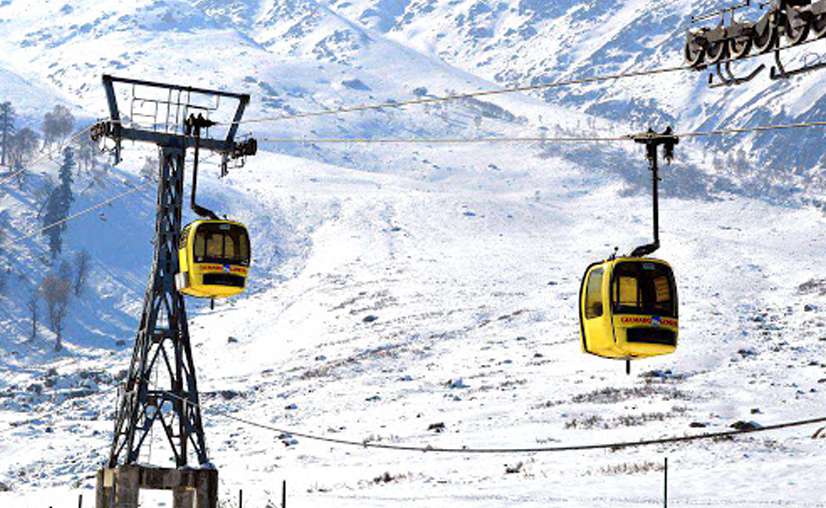

Not many destinations in the world can claim a distinct appeal in each season – Srinagar is one such place. Visualise this: set against the backdrop of Zabarwan mountains with river Jhelum winding its way through town, throw in the Dal lake and lesser known Nigeen lake into the mix for good measure, the stunning Mughal gardens with chinars – and it not surprising that epithets such as ‘heaven on earth’ were coined to describe it. The beauty of Kashmir valley has to be experienced to truly appreciate its bounty of nature. And Srinagar holiday packages more often than not sets the ball rolling to experience the valley. October through early November the flaming chinars (maple) are the top draw. Winter brings an abundance of snow, and related winter sport activities, while spring is a riot of colour especially at Asia’s largest Tulip festival, and during the pleasant summer months Srinagar is everyone’s favourite getaway for obvious reasons.
From kings and saints, to refugees from Persia to the Mughals and British, Sikhs and Dogras, Srinagar bewitched everyone. It fuses splendours of nature with riveting history to make it an amazing experience for one and all. Check the antiquity of the city at the Sri Pratap Singh Museum, visit the Harwan Garden to retrace Kushan emperor Kanishka role in spreading Buddhism, walk the playground Jahangir and Nur Jahan in Shalimar Garden or simply take a shikara ride on Dal lake with striking views of the Zabarwan ranges. The city’s architecture too boasts of varied influences. From the temple on Shankaracharya Hill, to the Khanqah of Shah Mandan and Hazratbal, and the palace of Maharaja Hari Singh (now a heritage property), a Srinagar package is always memorable.
Best Time to visit Srinagar
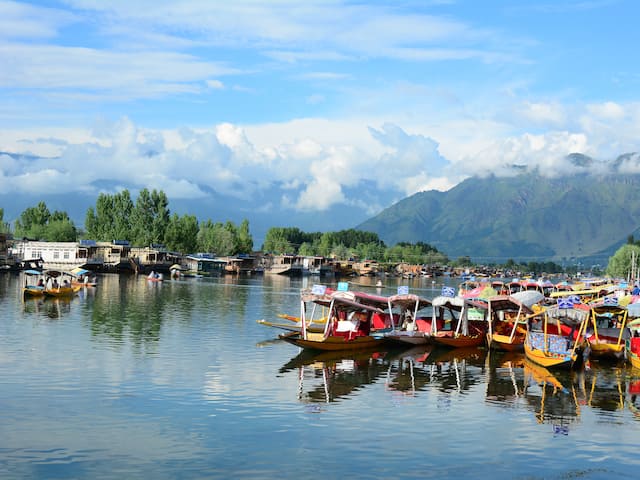
Srinagar is a year round destination. Winter for example is increasingly becoming a very attractive season with start of the glass-ceiling Vistadome coach train ride from Banihal. The snowfall season and winter activities like ice skating, world class ski facilities at nearby Gulmarg, and snow leopard sighting at Dachigam National Park makes this season a delight. Spring is the best season if you love flowers and are a horticulturist at heart. This is the season of colour, all roads lead to the Indira Gandhi Tulip garden by the Dal Lake. Summer is by far the most popular, as people in the plains look to beat the heat in the cool climes of Kashmir. Autumn is for people with an artistic bent of mind. The fall season colours can be seen at the Shalimar and Nishat Bagh, besides the many other gardens and countryside. Both spring and autumn are a spectacle of colours, albeit of a different kind. The play of flowers vis-à-vis leaves!
Things To Do in Srinagar
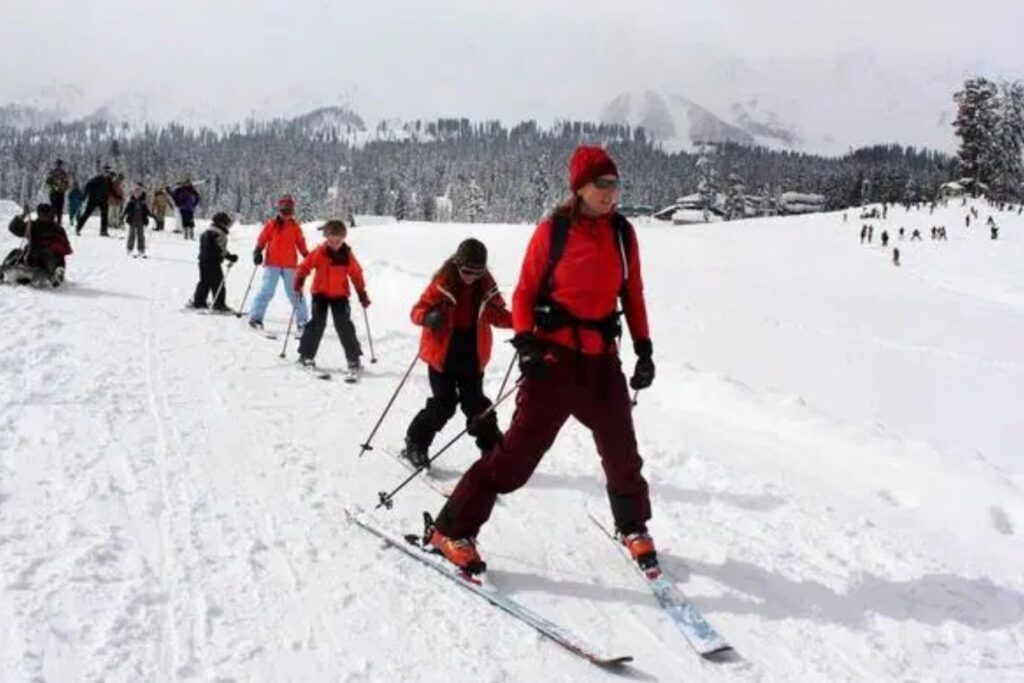
1. Skating on the Frozen Dal Lake
The season of Chillai Kalan in Srinagar brings a charm all its own. The Dal Lake freezes and becomes a playground for winter sports such ice-hockey, ice skating among others. This cold spell from late December through January is a major draw for winter tourists, who can supplement the frozen Dal Lake experience with a train ride in the glass-ceiling Vistadome coach from Banihal to Srinagar. Add it to your Srinagar tour package this winter for a never before experience. The thought of watching snowfall on the glass-ceiling Vistadome is indeed captivating. And finally top it off with skiing in the slopes of nearby Gulmarg. If you are using the train get off at Majhaun station for Gulmarg.
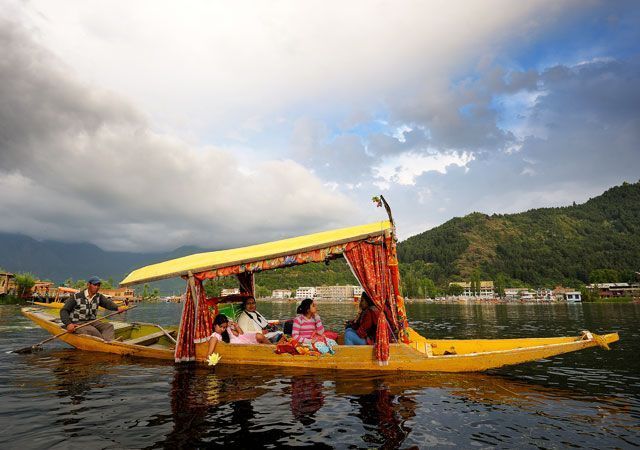
2. Shikara Rides on Dal and Nigeen Lakes
One of the singular attractions of Srinagar is a shikara ride in the Dal Lake. Set against the backdrop of the Zabarwan range, the lake gives travellers a superb perspective of some of the town’s leading attractions such as the famous Mughal gardens – Shalimar and Nishat, the much revered Hazratbal shrine with the hair relic of Prophet Muhammad, and the houseboats anchored along its shores. Shopping for fruits, vegetables, food, snacks in floating bazaars of Dal Lake is another major experience not to be missed. If nothing else, just buy a chai/tea from a vendor on his wooden shikara, have a word with him before gliding away into the serene waters. The lesser known Nigeen is ideal for those travellers looking for a quitter experience. The Dal Lake can get crowded during the summer months.
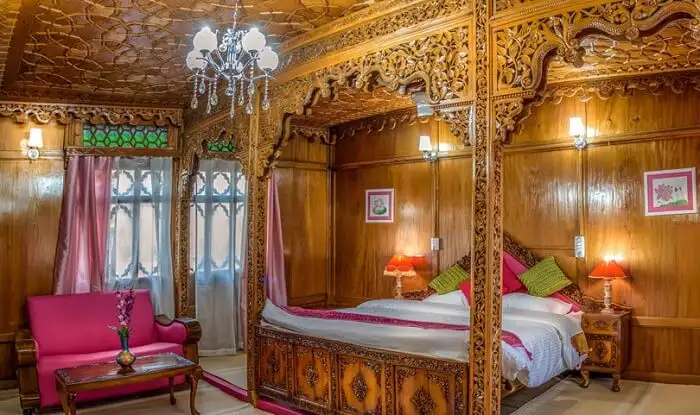
3. Stay in a Houseboat
While there is no dearth of hotels in touristy Srinagar, the real charm of this place is to live in a houseboat by the Dal Lake or on the Nigeen Lake. During the British Raj, the colonisers loved visiting the valley to escape the heat of the plains. However, the ruling Dogra kings denied them permission to buy land in the Kashmir Valley. Thus was born the concept of floating houseboats. A concept lends a rather distinct experience on a visit to this enchanting land. Hop on to a shikara anytime, enjoy the famed Kashmiri cuisine and its saffron tea while enjoying the scenic beauty all around!
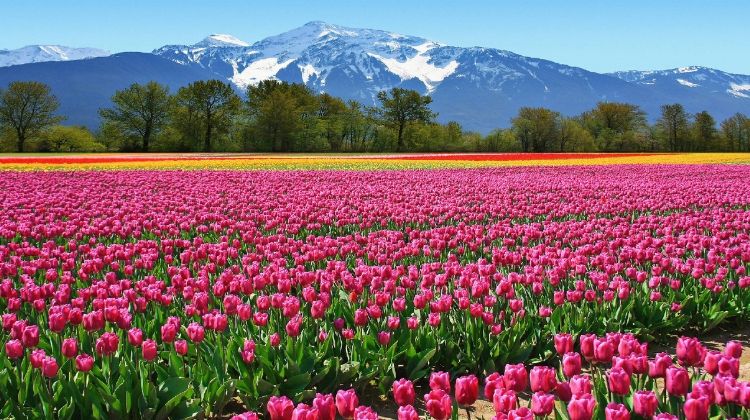
4. Buy Tulips at Indira Gandhi Tulip Garden
Travellers visiting Srinagar in spring should not miss the Indira Gandhi Tulip Garden. Asia’s largest tulip garden located along the Dal Lake and slopes along the foothills of Zabarwan range spreads across 74 acres. Started in 2007 to encourage floriculture and draw tourists, it produces well over a million tulip bulbs, and travellers can also see hyacinths, daffodils and ranunculus as well.
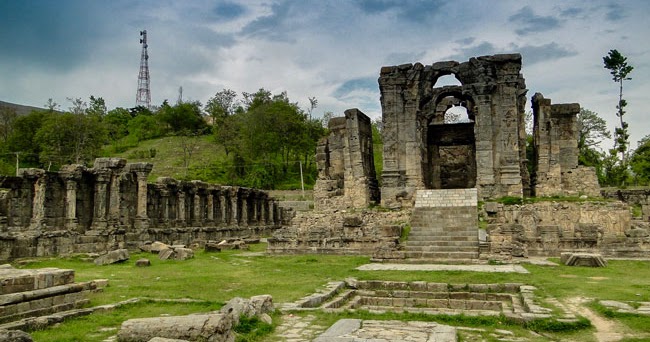
5. Drive to the Martand Sun Temple
Kashmir’s history has strong imprints of Buddhism, Hinduism and Islam. While Kanishka, the Kushan king, held the Fourth Buddhist Council in the Valley, King Lalitaditya built grand temples like the famous Sun Temple called Martand in southern Kashmir. Likewise Avantipur and Pandrethan too have historic temples, not to mention the Shiva temple on Shankaracharya hill. This is a day outing from Srinagar.
Places to Visit in Srinagar
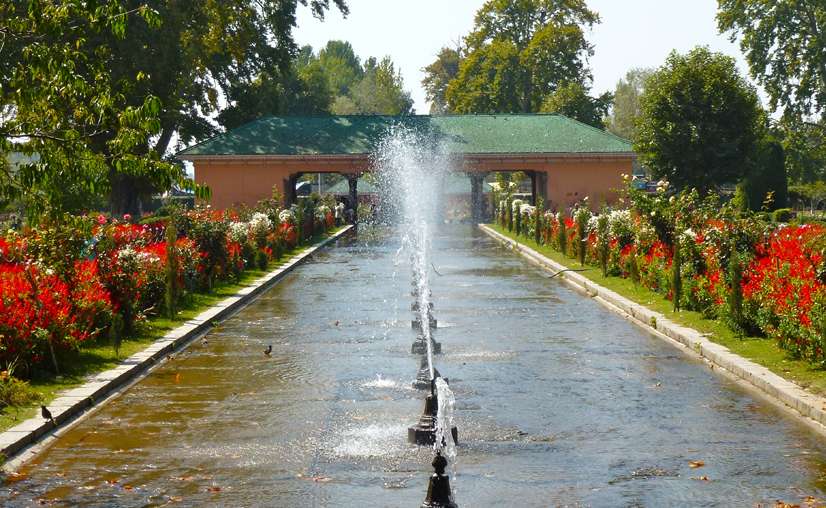
1. Shalimar Bagh (Garden)
This is where the Mughal emperor Jahangir romanced his beautiful wife Nur Jahan. Built in the early 17th century the garden’s stately chinar (maple) trees are set amidst terraced water channels. In spring season the garden is a riot of colour, while in autumn the flaming chinar trees in many shades of gold, rust, orange and red are a spectacle for the visual artist. Travellers with a yen for architecture and design would love the char bagh garden layout style inspired by Persian gardens, as also the stunning baradari housed within a water body with its painted ceiling. After the Mughals, the bagh continued to charm others rulers like the Maharaja Ranjit Singh and the later Dogras kings

2. Nishat Bagh (Garden)
Built by Jahangir’s brother-in-law Asaf Khan in 1633, the twelve tiered Nishat Bagh spread over 46 acres is dramatic in its setting. Located under the towering Zabarwan Hill on one side with the Dal Lake flanking the other end, Nishat Bagh’s twelve terraces represent each zodiac. In summers watching the sunset over the Dal Lake is a mesmerising, while snowline on the Zabarwan Hill offers a contrasting visual spectacle in winter.

3. Sri Pratap Singh Museum
For history buffs, a visit to this treasure trove is highly recommended. Artifacts from across larger Himalayan region including Kashmir, Ladakh, Baltistan and more are displayed. An ASI museum, this simply cannot be missed. Set aside half a day at the very least to understand the stories of Kashmir through objects. For example, the sculptures from Pandrethan, Parihaspora and Avantipura are gems.

4. Pari Mahal
Prince Dara Shikoh, Shah Jahan’s favourite son, was deeply influenced by Sufism. He created a terraced garden with seven tiers as a retreat for Sufis. Pari Mahal, which means the Angels’ Abode, overlooks the Dal Lake and Srinagar town. Dara Shikoh lived here for long stretches between 1640 to 1654. It has also functioned as an training ground for students of astronomy and astrology. Beautifully located, with the Royal Springs Golf Course right below, Pari Mahal is a lovely retreat even for the contemporary traveller.

5. Cheshma Shahi Garden
The smallest of the three Mughal gardens, it was constructed around the spring by the Mughal Governor Ali Mardan Khan in 1632 under the order of the emperor. Chashma Shahi means the royal spring, lovers of Persian garden design should visit Chashma Shahi. A gift by Shah Jahan to his favourite son Dara Shikoh, Persian influence is all pervasive in the layout and plantations.

6. Harwan Garden
This garden predates all other gardens in the Srinagar region. The 4th Buddhist Council was held here by the Kushan king Kanishka in 78 CE. Today it is a 30-minute drive from the city centre, located high up in the hills in Harwan village. A water channel with chinar trees, flower beds, large green lawns awaits the traveller. It can be clubbed with a visit Dachigam National Park, which located nearby.

7. Khanqah of Shah Mandan
Escaping the wrath of Temur’s tyranny in Iran, Mir Sayyid Ali Hamadani and his band of followers found refuge in Kashmir. A sufi from the Kubrawiya order, he played a part in the spread of Islam in the Kashmir valley. The Khanqah also known as Shah-e-Hamadan Masjid stands on a squarish platform, and architecturally has many influences from Buddhist, Hindu and Islamic styles.

8. Shakaracharya Hill
Overlooking Srinagar town is the Shankaracharya Hill with a temple dedicated to Lord Shiva. The Shankaracharya Temple, located 1000 feet above the valley floor in the Zabarwan range, is a monument of national importance, and is under ASI. It offer spectacular views of the Kashmir valley. The Advaita philosopher Adi Shankara in his journeys across the country to revive Hinduism, when India was mostly Buddhist, is believed to have visited this temple.

9. Hazratbal Shrine
It is hard to miss this striking white structure. Scenically located by the Dal Lake, its white dome structure was added in the late 20 th century to the original structure built in the 17 th century by Mughal subedar Sadiq Khan during the reign of Shah Jahan. Also called Dargah Sharif, the hair relic of Prophet Muhammad makes it a place of significance. Hazratbal shrine was initially established by Inayat Begum, daughter of Khwaja Nur-ud-Din Eshai who was the original custodian of the holy relic. It changed multiple hands before it found its home at Hazratbal.

10. Tomb of Zain-ul-Abidin’s Mother
This 15th century tomb of Zain-ul-Abidin’s mother is a curious piece of architecture with elements of Gandhara School of Art, Byzanthine church architecture and terracotta temples of Bishnupur in Bengal. Zain was a progressive king, and he tomb with its varied elements lends a distinct flavour to the architectural narrative in the Kashmir valley.

11. Hari Parbat Hill and Fort
Towering over Srinagar is the Hari Parbat Hill. According to Hindu mythology, Parvati Devi destroyed a demon here. A temple dedicated to Shiv-Parvati is one of attractions within the fort, which came up subsequently. Built during Akbar’s reign, work on the fort was started and significant progress made, but the fort was completed only a few centuries later by the Durrani rulers.

12. Indira Gandhi Tulip Garden
Travellers visiting Srinagar in spring should not miss the Indira Gandhi Tulip Garden. Asia’s largest tulip garden located along the Dal Lake and sloping along the foothills of Zabarwan range spreads across 74 acres. Started in 2007 to encourage floriculture and draw tourists, it produces over a million tulip bulbs, and travellers can also see hyacinths, daffodils and ranunculus.